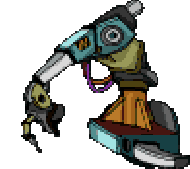Types Of Joints And Degrees Of Freedom In Robots

Robot joints are connections between two links that permit relative motions between them.
The main purpose of the joint in robots is to provide a controlled relative movement between the two connected links normally called the input links and the output links.
Links are considered to be a rigid component of the robot mechanism. Usually, each joint provides the robot with one degree of freedom of motion.

The degree of freedom of a joint can be described as the only possible and obtainable direction of motion at the joint.
Robots may be classified according to the total number of degrees of freedom they possess.
There are five main types of joints. Two types provide linear motion while three types provide rotary motion.

Nearly all industrial robots have joints that can be classified into any of the five types.
- Linear joint: in linear joints, the relative motion between the input and output link is a linear sliding motion, with the axis of the two links being parallel. This type of joint is called type l-joints.
- Orthogonal joint: this type of joint provides rotational relative motion with the axis of rotation perpendicular to the axis of the input and output links. They are called the R-joints by type.
- Twisting joint: this type of joint permits rotational relative motion between two links with an axis of rotation parallel to the axis of the two links. They are called type T-joint.
- Revolving joint: this type of joint permits rotational relative motion between the two links with the axis of the input link parallel to the axis of rotation of the joint and the axis of the output link perpendicular to the axis of rotation of the joint. It is known as type V-joint.
Identifying the links and joints in a robot
In all robots, each of the joint types has a range over which it can be moved.
For instance, the linear joint may be from several inches or millimeters to several feet or meters.
For rotary motion, it may be as small as a few degrees to as large as several complete turns.
The robot is made up of several links. At any point in time, two adjacent links must be identified, one as an input link, and the other as an output link. Most of the robots are mounted on a stationary base.
This can be referred to as link O. it is the input link to joint 1 which is the first link in the series of joints used in the construction of the robot.
The output link of joint 1 is link 1, which is the input link to joint 2 whose output is link 2, and so on.

The degree of freedom (D.O.F)
The degrees of freedom are the obtainable directions of motion of the link at any joint. In nearly all cases, one link can only produce one degree of freedom.
Generally, a robot could be considered to be made up of two main sections which are;
Body and arm assembly, and wrist assembly.
The wrist assembly is made up of the wrist and the end-effectors. The object to be moved is handled by the manipulator’s wrist with the aid of the end efforts.
The body and arms help to position the object. It normally has three (3) degrees of freedom, described as follows:
Vertical transverse: this is the up and down vertical movement of the arm in the Z-direction. This can be achieved in two ways;
By pivoting the entire arm about the horizontal axis on the base so that the vertical transverse is a typical vertical oscillatory motion of the arm about some pivot on the base.
By moving the arm along a vertical slide fixed on the base to produce linear and down vertical motions.
Radial transverse: this is the extraction and retraction of the arm in the radial direction of the rotational transverse. It is also known as in-and-out motion in the y-direction.
Rotational transverse: this is the rotation or swivel of the robot arm, right or left about the vertical axis on the base. It is also known as the X-axis swivel about the vertical axis.
After positioning the object using the body-and-arm assembly, the wrist is then used to orient the object. To establish the orientation of the object, the wrist also has three degree-of-freedom described as follows:
- Wrist Swivel: it is made up of the rotation of the wrist about the arm axis. It is achieved by a T-type joint.
- Wrist Bend: this is the up and down rotation of the object about the arm axis. It is achieved by an R-type joint.
- Wrist aw: this is the right-to-left rotation of the object about the arm axis, also accomplished by an R-type joint.
The letter symbol of the five joint types can be used to define a joint’s rotation system for the robot manipulator.
In this rotation system, the manipulator is described by the joint types that make up the body and arm assembly, followed by the joint symbols that make up the wrist.
For example, the rotation TLR; TR represents a five degree-of-freedom manipulator whose body and arm are made up of a twisting joint i.e. the joint 1, a linear joint i.e. the joint 2, and a rotational joint i.e. the joint 3.
The wrist consists of two joints, a twisting joint i.e. joint4, and a rotational joint i.e. joint 5.
The order of the sequence of joints as stated in this rotation system starts from the base and moves towards the end effectors.
A colon separates the body–and–arm rotation from the wrist rotation.

Does your website have a contact page? I’m having problems locating it but, I’d like
to shoot you an email. I’ve got some ideas for your blog you might be interested in hearing.
Either way, great website and I look forward to seeing it improve over time.